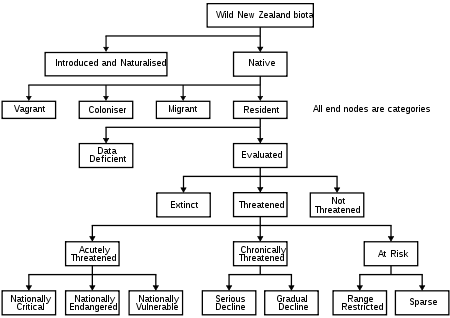- New Zealand Threat Classification System
-
The New Zealand Threat Classification System is used by the Department of Conservation to assess conservation priorities of species in New Zealand.[1]
The list was developed since the IUCN Red List, a similar conservation status system, had some shortcomings for the unique requirements of conservation ranking in New Zealand.
Contents
Categories
Species that are ranked are assigned categories and
- Introduced and Naturalised
These are any species that are deliberately or accidentally introduced into New Zealand.
- Vagrant
Vagrants are taxa that are rare in New Zealand that have made their own way and do not breed successfully.
- Coloniser
These taxa have arrived in new Zealand without human help and reproduce successfully.
- Migrant
Migrant species are those that visit New Zealand as part of their life cycle.
- Data Deficient
This category lists taxa for which insufficient information is available to make as assessment on conservation status.
- Extinct
Taxa for which there is no reasonable doubt that no individuals exist are ranked as extinct. For these lists only species that have become extinct since 1840 are listed.
- Threatened
This category has three major divisions:
-
- Acutely Threatened
This division is further broken down into:
-
-
- Nationally Critical - equivalent to the IUCN category of Critically endangered
- Nationally Endangered - equivalent to the IUCN category of Endangered
- Nationally Vulnerable - equivalent to the IUCN category of Vulnerable
-
-
- Chronically Threatened
This has two categories:
-
-
- Serious Decline
- Gradual Decline
-
-
- At Risk
This has two categories:
-
-
- Range Restricted
- Sparse
-
- Not Threatened
If taxa fit into none of the other categories they are listed in the Not Threatened category.
Qualifiers
A series of qualifiers are used to give additional information on the threat classification:[1]
EW Extinct in the Wild Exists only in cultivation or in captivity CD Conservation Dependent Likely to move to a higher threat category if current management ceases DP Data Poor Confidence in the listing is low due to the poor data available for assessment RC Recovering Total population showing a sustained recovery ST Stable Total population stable SO Secure Overseas Secure in other parts of its natural range outside New Zealand TO Threatened Overseas Threatened in those parts of its natural range outside New Zealand HI Human Induced Present distribution is a result of direct or indirect human activity RF Recruitment Failure Current population may appear stable but the age structure is such that catastrophic declines are likely in the future EF Extreme Fluctuations Extreme unnatural population fluctuations, or natural fluctuations overlaying human-induced declines, that increase the threat of extinction
OL One Location Found at one location (geographically or ecologically distinct area) in which a single event (e.g. a predator irruption) could soon affect all individuals of the taxon
See also
References
- ^ a b Molloy, Janice; Bell, B.; Clout, M.; de Lange, P.; Gibbs, G.; Given, D.; Norton, D.; Smith, N.; Stephens, T. (2002). "Classifying species according to threat of extinction. A system for New Zealand" (pdf). Department of Conservation (New Zealand). http://www.doc.govt.nz/upload/documents/science-and-technical/TSOP22.pdf. Retrieved 2008-02-29.
External links
Categories:- Conservation in New Zealand
- Biota by conservation status system
Wikimedia Foundation. 2010.

